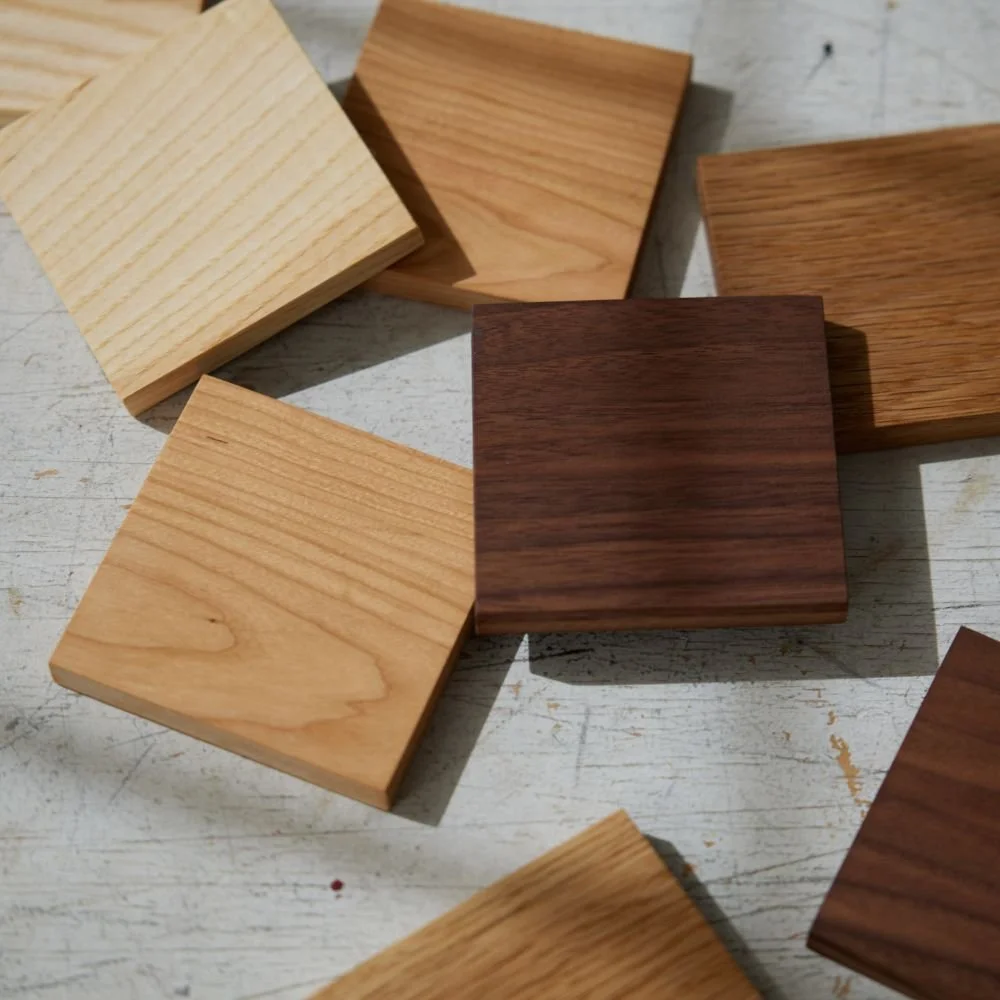A Guide to Choosing a Wood Species for Your Project
Selecting a wood species for your furniture project is an exciting part of the process, though for some it can be a major point of “analysis paralysis” that can leave you going back and forth between various options.
To help you through this process, Turkey Tail and Woodcraft has meticulously selected to offer four domestic American hardwoods: Ash, Cherry, White Oak, and Black Walnut. I believe that each of these is extremely well suited to home furniture, both in their durability and aesthetic beauty, and that each offers a slightly different flavor that all but guarantees one will fit your taste.
Before jumping into the details of the various wood species that Turkey Tail Design + Woodcraft offers, I find that taking a moment to answer the following questions can often be very helpful in narrowing down your selection.
Do you have any existing wood furniture in the room? What species, or tones of wood are they? Warm, neutral, cold? Dark brown, light brown, olive, cream?
Aesthetically, are you looking for something bold (i.e. a statement piece), or something that will blend in?
Do you want something that is going to match the rest of the room, or provide a contrast?
Once you have an understanding of your preference of the above, you are in a much better place for choosing a species.
With that, let’s jump into our options:
Ash
Boasting incredible durability (it’s used to make baseball bats!), Ash has a consistent straight-grain pattern and a light color that pairs perfectly with the sleek modern aesthetic. I think ash works best in bright rooms where light can help capture the gorgeous sheen across a table top. Given its light, almost cream color, I find that Ash can also provide a sense of subtlety and serenity to a space.
If you are looking to make a statement, Ash also can be a really interesting contrasting wood to some warmer toned furniture, such as Mahogany or Cherry.
Cherry
Cherry is a species that rewards those with patience. When first milled, it has a salmon pink hue, but over time (typically about 6 months), as the surface accepts sunlight, it turns to an amazingly warm reddish-brown tone with a patina that is second to none. This process continues for the life of the piece, and acts as a symbol of heirloom quality. Cherry is prized for its classic beauty and sophistication, making it suitable for both traditional and contemporary designs.
If you have other pieces of dark antique furniture, Cherry will blend in splendidly. If you have a room that has more light tones and nice natural lighting, expect cherry to act as more of a statement piece.
White Oak
When you close your eyes and think of generic “wood”, you are probably picturing White Oak, and for good reason. White Oak has been a staple species used in American furniture due to its incredible strength and density, weather resistance, and mesmerizing cathedral-shaped grain pattern. Though much of the DIY trend has led people to believe they need to stain White Oak, we absolutely love its natural color when accentuated with an oil based finish. White Oak features a light to medium brown color with a slightly olive tone, and the grain tends to be wide and prominent. Depending on how the lumber was cut, you may also see beautiful medullary rays that dance across the grain.
Given White Oak’s wide and open grain, I find that it works great on larger pieces as these tend to really show off the grain. If you are ever worried about your furniture feeling dainty or light, White Oak is also excellent as it is an incredibly dense and heavy wood.
Black Walnut
Those looking for subtlety need not apply. Black walnut is an incredibly popular hardwood as it boasts rich chocolate tones, with hints of caramel in the swirling interplay between heartwood and sapwood. Walnut offers a truly sophisticated and luxurious appearance, which is perfect for making a statement in your home. With grain that is anything but straight, one could spend hours following the twists and swirls, making Black Walnut a true showstopper in any setting. When placed in a light room, Walnut tends to highlight its more caramel tones, while in a darker setting it may appear a bit more dark chocolate.
Over time, expect light exposure to slightly lighten the color of Walnut towards the more caramel tone, while continuing to enhance the sheen with a gorgeous natural patina.
In Conclusion
At the end of the day, there are no wrong answers. We offer these four wood species as we believe they can all match, compliment, or even contrast your existing home decor effectively. All of these woods accept our preferred hardwax-oil finish spectacularly, and there is a great reason they have all been used for centuries in American furniture. Whichever option you choose, rest assured I will transform your vision into a stunning, handcrafted masterpiece that will be cherished for years to come.
Still uncertain about the options? I strongly encourage you to purchase one of our wood sample kits so you can see each species directly in your home. As an added bonus, they make fantastic drink coasters.





